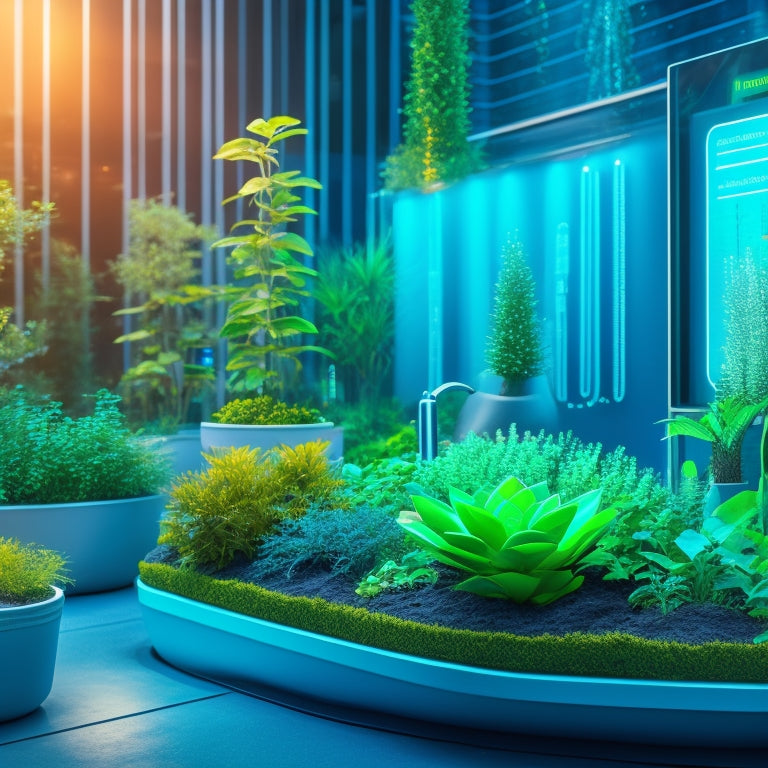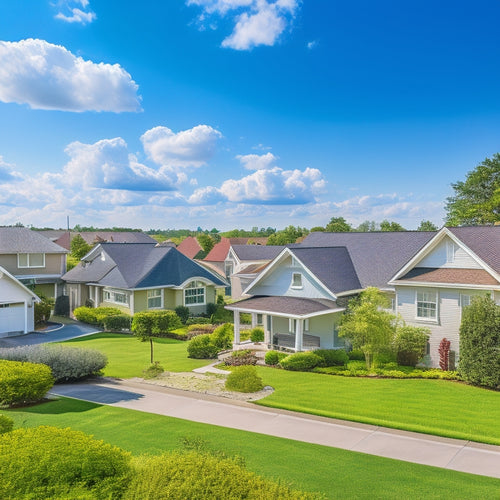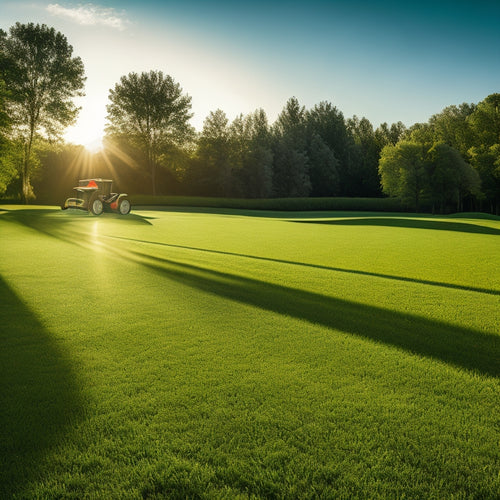
Why Monitor Energy in Urban Gardening Tools?
Share
By monitoring energy in urban gardening tools, you can optimize tool performance, reduce energy waste, and lower your carbon footprint. You'll be able to identify energy-wasting tools, adjust gardening schedules to reduce peak energy hours, and make data-driven decisions to enhance your garden's overall health and productivity. You'll also gain cost savings, maximize renewable energy sources, and allocate resources more effectively. By understanding energy consumption patterns, you'll be able to refine your gardening practices and make a positive impact on the environment. Now, take the next step in converting your urban garden into a sustainable oasis.
Key Takeaways
- Monitoring energy in urban gardening tools optimizes tool performance, minimizes energy waste, and reduces carbon footprint.
- Energy monitoring identifies inefficient tools, allowing for upgrades to energy-efficient alternatives and reduced energy bills.
- Tracking energy consumption informs data-driven decisions on resource allocation, reducing waste and optimizing expenditure.
- Monitoring energy usage enables the identification of opportunities for renewable energy integration, reducing reliance on non-renewable energy.
- Energy monitoring promotes sustainable gardening practices, enhancing overall garden health, productivity, and environmental sustainability.
Energy Efficiency in Urban Gardens
In the midst of lively cities, urban gardens are sprouting up, providing a tranquil oasis for residents and a haven for local wildlife.
You're likely part of this movement, cultivating a green space that promotes urban biodiversity and community engagement. To guarantee the long-term sustainability of your garden, adopt energy-efficient practices that prioritize soil health, pest management, and climate resilience.
Incorporating renewable energy solutions, such as solar panels to power irrigation systems and greenhouses, can greatly reduce your carbon footprint. Implement water conservation methods, crop rotation, and use organic fertilizers to reduce your carbon footprint.
Incorporate native plants that require minimal maintenance and care. By doing so, you'll create a thriving ecosystem that not only benefits your community but also contributes to a more environmentally conscious future.
Optimizing Tool Performance Matters
You can greatly reduce your urban garden's carbon footprint by optimizing your tool performance, which starts with enhancing tool efficiency.
By doing so, you'll not only minimize energy waste but also maximize battery life, saving you time and resources.
Furthermore, implementing strategies like time-of-use rate optimization and load management can help reduce energy costs and enhance overall efficiency.
Boost Tool Efficiency
By fine-tuning your urban gardening tools, you can release significant energy savings and enhance their overall performance.
Conducting energy audits on your tools helps identify areas of inefficiency, allowing you to make data-driven decisions to optimize their performance.
Implementing energy-efficient practices, such as load balancing, can further enhance tool sustainability, reducing your carbon footprint and contributing to a cleaner environment.
This, in turn, elevates tool sustainability, reducing your carbon footprint and contributing to a cleaner environment.
By streamlining your tools' energy consumption, you'll not only minimize waste but also enjoy cost savings.
Take control of your urban gardening practice and make a positive impact on the planet.
Maximize Battery Life
Fine-tuned tools reduce energy waste, but even optimized equipment can't compensate for poor battery life. You need to maximize battery life to get the most out of your urban gardening tools.
Regular maintenance practices greatly influence battery longevity maintaining peak performance, and consistent checks enhance safety and reduce risks associated with battery systems. To do this, follow battery maintenance tips such as storing batteries in a cool, dry place, avoiding deep discharging, and keeping them clean.
Energy monitoring tools can also help you identify areas of inefficiency and optimize your tool's performance. By monitoring energy usage, you can adjust your gardening routine to minimize waste and reduce your carbon footprint.
With optimized battery life, you'll have the freedom to focus on what matters most - growing a thriving and sustainable urban garden.
Reducing Carbon Footprint Impact
As urban gardening tools become increasingly sophisticated, their carbon footprint grows, too, with energy consumption being a notable contributor. You can reduce this impact by adopting sustainable practices in your eco-friendly gardening routine.
Monitoring energy consumption helps you identify areas for improvement, allowing you to make data-driven decisions. By choosing energy-efficient tools and optimizing their use, you can minimize your carbon footprint. For instance, switching to solar-powered or battery-powered tools can considerably reduce your reliance on fossil fuels, much like solar-powered EV charging stations lower energy bills and provide a stable energy supply.
Additionally, achieving energy independence minimizes reliance on the grid, enhancing brand reputation and attracting environmentally conscious customers. Implementing smart gardening techniques, such as precision irrigation and crop monitoring, can further decrease energy consumption.
Understanding Energy Consumption Patterns
One key aspect of reducing your urban gardening tools' carbon footprint is understanding their energy consumption patterns.
By analyzing how much energy your tools use, you can identify opportunities to optimize their performance and reduce waste. Consumption analysis helps you track energy trends, pinpointing which tools are guzzling the most power and when.
This understanding allows you to:
- Identify peak energy hours and adjust your gardening schedule accordingly
- Optimize tool usage to reduce energy consumption during off-peak hours
- Invest in energy-efficient tools to replace outdated, power-hungry ones
- Develop a data-driven strategy to minimize your garden's carbon footprint
Identifying Energy-Wasting Tools Quickly
Your urban garden's energy-hungry culprits are hiding in plain sight. It's time to identify them and take action. Conducting regular energy audits helps you pinpoint which tools are guzzling the most energy.
You'll be surprised at how much you can save by making a few strategic changes. Start by tracking the energy consumption of each tool, then identify areas for improvement.
Consider upgrading to energy-efficient alternatives or modifying your gardening schedule to reduce peak usage hours. By doing so, you'll not only reduce your energy bills but also minimize your carbon footprint.
With tool upgrades and energy audits, you'll be well on your way to a more sustainable and energy-conscious urban garden.
Maximizing Renewable Energy Sources
You're taking control of your urban garden's energy consumption, and now it's time to think outside the grid.
By leveraging renewable energy sources, you can reduce your reliance on non-renewable energy and minimize your carbon footprint.
Here are some ways to maximize renewable energy sources in your urban garden:
-
Integrate solar panels to power your gardening tools and lighting systems
-
Employ wind energy to generate electricity for your irrigation systems and pumps
-
Incorporate bioenergy systems that convert organic waste into energy
- Implement geothermal energy solutions to regulate soil temperature and extend the growing season
Cost Savings Through Monitoring
By utilizing renewable energy sources, urban gardeners can greatly reduce their environmental impact.
As you integrate green energy into your urban gardening tools, monitoring energy consumption becomes essential for cost savings. By keeping track of your energy usage, you can identify areas of inefficiency and make adjustments to optimize your system.
This leads to significant cost benefits, allowing you to allocate your budget more effectively. Effective budget management enables you to invest in more sustainable practices, creating a positive feedback loop.
With energy monitoring, you'll be able to pinpoint opportunities to reduce waste and optimize your energy expenditure, ultimately freeing up resources to focus on what matters most - nurturing your urban garden.
Data-Driven Gardening Decisions Made
You'll make data-driven gardening decisions by identifying areas of energy waste, allocating resources efficiently, and scheduling irrigation informed by real-time data.
This approach enables you to pinpoint opportunities to reduce energy consumption, minimizing your environmental footprint.
Energy Waste Identification
Your urban garden's energy efficiency relies heavily on identifying areas of energy waste, an essential step in making data-driven gardening decisions.
By conducting regular energy audits, you can pinpoint where energy is being squandered and take corrective action. This process helps you understand your usage patterns, allowing you to optimize your energy consumption and reduce waste.
Some key areas to focus on include:
- Inefficient irrigation systems that waste water and energy
- Overuse of energy-intensive gardening tools during peak hours
- Poorly insulated greenhouses that let heat escape
- Inadequate lighting systems that consume excessive energy
Optimal Resource Allocation
Energy-efficient gardening demands strategic resource allocation, and data-driven choices are key to achieving this goal.
By monitoring your urban gardening tools' energy consumption, you can enhance resource distribution and energy budgeting. This allows you to allocate your energy budget effectively, ensuring each tool is used efficiently.
Data-driven understandings help you identify areas of improvement, enabling you to make informed decisions about resource distribution. With ideal resource allocation, you can reduce energy waste, minimize your environmental footprint, and enjoy the freedom to focus on nurturing your garden.
Informed Irrigation Scheduling
With precise irrigation scheduling, urban gardeners can access significant water and energy savings, reducing their environmental impact while nurturing healthy, thriving plants.
You can make data-driven gardening decisions by leveraging real-time data on weather conditions, soil moisture, and crop water requirements. This informed approach enables you to:
- Optimize irrigation frequency and duration based on soil moisture levels
- Adjust irrigation schedules according to weather forecasts, avoiding unnecessary watering during rainfall
- Identify areas of water waste and implement corrective measures
- Automate irrigation processes, ensuring consistent and efficient watering practices
Frequently Asked Questions
How Do I Choose the Right Energy Monitor for My Urban Garden?
When selecting an energy monitor for your urban garden, you'll want to contemplate tracking energy consumption to optimize tool effectiveness, ensuring you're using resources efficiently and reducing your environmental footprint, ultimately giving you the freedom to grow a thriving, sustainable garden.
Can Energy-Efficient Tools Reduce Noise Pollution in Urban Areas?
You'll find that energy-efficient tools can greatly reduce noise pollution in urban areas, contributing to a more peaceful environment and promoting urban sustainability; by choosing the right tools, you'll be doing your part in reducing noise reduction and creating a more livable space.
Do Energy Monitors Work With Solar-Powered Gardening Tools?
Like a green thumb unfolding, you'll uncover that energy monitors seamlessly integrate with solar-powered gardening tools, optimizing solar efficiency and accelerating gardening innovation, giving you the freedom to cultivate a sustainable future, one harvest at a time.
Can I Use Energy Monitoring Data to Optimize My Irrigation System?
You can optimize your irrigation system by analyzing energy monitoring data to identify opportunities to enhance irrigation efficiency, reducing waste and conserving resources, and making data-driven decisions to create a more sustainable and self-sufficient garden.
Are Energy Monitors Compatible With Existing Urban Gardening Infrastructure?
As you "gear up" for a futuristic garden, you're wondering if energy monitors can seamlessly integrate with your existing urban gardening infrastructure. The answer is yes, many modern garden technology solutions are designed to promote urban sustainability, easily syncing with your current setup for a greener tomorrow.
Related Posts
-

Why Choose Recycled Paper for Earth-Conscious Business?
By choosing recycled paper, you'll greatly reduce your business's environmental impact. You'll lower your carbon foot...
-

What Cool Roof Tax Breaks Can Homeowners Claim?
You can claim federal tax credits of up to $500 and state and local incentives for installing cool roofs, which not o...
-

10 Powerful Electric Mowers for Expansive Lawns
You're moving away from gas-powered mowers and exploring electric options for your expansive lawn. You'll find that h...


